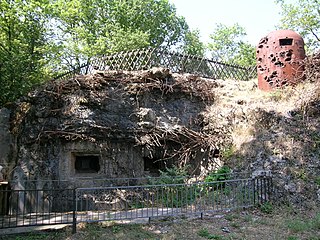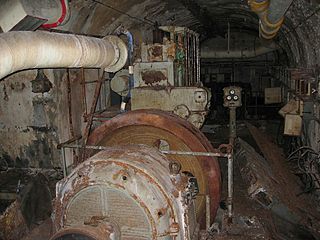
Ouvrage Mont des Welches, a gros ouvrage of the Maginot Line fortifications, is part of the Fortified Sector of Boulay. It comprises two entrance blocks, one infantry block, one artillery block, one observation block and two combination blocks. It is located between petit ouvrage Coucou and gros ouvrage Michelsberg, facing Germany. Relatively small for a gros ouvrage, Mont des Welches saw a brief period of sharp action in June 1940, when German forces moving along the rear of the Maginot Line engaged the position without success. After modest renovations in the 1950s, Mont des Welches was abandoned in the 1970s.

Ouvrage Anzeling is a gros ouvrage of the Maginot Line, part of the Fortified Sector of Boulay. It is located between petit ouvrage Bousse and petit ouvrage Berenbach, facing Germany just to the east of Bockange. With one of the longest main galleries of any Maginot position, it consists of two entrance blocks, three infantry blocks and four artillery blocks. A second phase of construction was planned to add nine more combat blocks and an anti-tank ditch, but was never executed. Anzeling saw limited action in World War II, and was rehabilitated for use during the cold war. It was de-activated in the 1970s and sold for private use.

Ouvrage Coucou is a lesser work of the Maginot Line, located in the Fortified Sector of Boulay. The ouvrage consists of two infantry blocks, and is located between the gros ouvrages of Hackenberg and Mont des Welches, facing Germany, just north of Kemplich.

Ouvrage Hobling is a lesser work of the Maginot Line. Located in the Fortified Sector of Boulay, the ouvrage consists of two infantry blocks and two observation blocks, and is located between gros ouvrage Michelsberg and petit ouvrage Bousse, facing Germany. It has been stripped of metals and abandoned.

Ouvrage Bousse, also known as Ouvrage Bois de Bousse, is a lesser work of the Maginot Line in the Fortified Sector of Boulay. The ouvrage is located between petit ouvrage Hobling and gros ouvrage Anzeling, near Hestroff in the Bois du Bousse, facing Germany. A small position, it was manned primarily by reservists. It is noted for the events of 15 June 1940, when it received orders to prepare for an evacuation as German forces advanced along the Line in the Battle of France. As the garrison prepared to abandon the position, sabotaging equipment, they destroyed their telephone connection, leaving them unable to receive the order countermanding the evacuation. The garrison was captured three days after leaving Bousse. Bousse is now managed as a museum and is open to public visitation.

Ouvrage Berenbach, also known as Ouvrage Behrenbach, is a lesser work of the Maginot Line. Located in the Fortified Sector of Boulay, the ouvrage is located between gros ouvrage Anzeling and petit ouvrage Bovenberg, facing Germany. The ouvrage consists of two infantry blocks and one observation block. Uniquely, the blocks are not connected by subterranean galleries, as is the case in virtually all other Maginot fortifications.

Ouvrage Denting is a lesser work of the Maginot Line. Part of the Fortified Sector of Boulay, the ouvrage consists of three infantry blocks, and is located between petits ouvrages Bovenberg and Village Coume, near the village of Denting in Moselle département, facing Germany. The position saw little action in World War II.

Ouvrage Village Coume is a lesser work of the Maginot Line. Located in the Fortified Sector of Boulay, the ouvrage consists of three infantry blocks, and is located between petits ouvrages Bovenberg and Coume Annexe Nord, facing Germany. The position saw little action in World War II. It was sold in the 1970s and stripped by salvagers.

Ouvrage Coume is a lesser work of the Maginot Line. Located in the Fortified Sector of Boulay, the ouvrage consists of two infantry blocks, and was located between petits ouvrages Coume Annexe Nord and Coume Annexe Sud, facing Germany.

Ouvrage Coume Annexe Sud is a lesser work of the Maginot Line. Located in the Fortified Sector of Boulay, the ouvrage consists of two infantry blocks, one artillery block and one observation block, and is located between petits ouvrages Coume and Mottemberg, facing Germany.

Ouvrage Mottenberg is a lesser work of the Maginot Line. Part of the Fortified Sector of Boulay, the ouvrage consists of one entrance block and two infantry blocks, and is located between petits ouvrages Coume Annexe Sud and Kerfent, facing Germany.

Ouvrage Bambesch is a lesser work of the Maginot Line. Located in the Fortified Sector of Faulquemont, the ouvrage consists of three infantry blocks, and is located between petits ouvrages Kerfent and Einseling, facing Germany. Completed in 1932, it is located in the Bois de Bambesch. On 20 June 1940 during the Battle of France, Bambesch was attacked by German forces, whose artillery battered the position, which could not be effectively supported by its neighbors, into surrender. Since 1973, Bambesch has been operated as a museum and is open to the public.

Ouvrage Mauvais-Bois is a petit ouvrage of the Fortified Sector of the Crusnes on the Maginot Line. It is located between the gros ouvrage Latiremont and the petit ouvrage Bois-du-Four, facing the Belgium/Luxembourg border. The original plan for the position was for two phases of construction, resulting in a gros ouvrage provided with heavy artillery. The increase in tension between France and Germany in the late 1930s caused resources to be diverted elsewhere, and only the first three combat blocks were built. In 1940 the ouvrage was regularly bombarded, but not directly attacked by German infantry. When the French military divested itself of the majority of the Maginot fortifications, Mauvais-Bois was the second to be sold.

Ouvrage Bréhain is part of the Fortified Sector of the Crusnes of the Maginot Line, located near the community of Bréhain-la-Ville in the Meurthe-et-Moselle département of France. Bréhain is flanked by petits ouvrages Mauvais Bois and Aumetz. The gros ouvrage was equipped with long-range artillery, and faced the border with Luxembourg. It saw no major action in either the Battle of France in 1940 or the Lorraine Campaign of 1944. While not open to public visitation, it has been secured and is in relatively good condition when compared to other abandoned Maginot positions. A flanking casemate has been restored and may be visited.

Ouvrage Aumetz is a small work, or petit ouvrage of the Maginot Line. It is part of the Fortified Sector of the Crusnes and is located near the community of Aumetz in the Moselle département of France. The petit ouvrage flanked by the gros ouvrages Bréhain and Rochonvillers, all facing the France-Luxembourg border. Aumetz was initially planned as a gros ouvrage of six combat blocks, but only three infantry blocks were built. Aumetz saw limited action during the Battle of France. In the 1970s it was the first Maginot position to be offered for sale to the public.

Ouvrage Soetrich is a gros ouvrage of the Maginot Line in northeastern France. Soetrich is located between petits ouvrages Immerhof and Bois Karre, facing the France-Luxembourg border near the town of Hettange-Grande, part of the Fortified Sector of Thionville. Compared with other gros ouvrages, Soetrich is compact in arrangement, with the entries and underground ammunition magazines and barracks in close proximity to the combat blocks, accessed through underground galleries at an average depth of 30 metres (98 ft). Its primary purpose was to cover the main road to Luxembourg, just to the west. Along with its neighbors, Ouvrage Rochonvillers and Ouvrage Molvange, Soetrich was used during the Cold War as a secure command center for NATO forces.

Ouvrage Otterbiel forms part of the Maginot Line in the Fortified Sector of Rohrbach, Sub-sector of Bitche, and is located on the Camp de Bitche of the French Army. It is located between gros ouvrage Schiesseck and petit ouvrage Grand Hohekirkel. Part of the Fortified Sector of Rohrbach, the petit ouvrage comprises four combat blocks and an entry block. Due to budget restrictions, a planned flanking infantry block was never constructed. Otterbiel saw no significant action in the Battle of France, and limited action during the 1944/45 Lorraine Campaign. It was renovated for use during the Cold War. Otterbiel is used for ammunition storage by the French Army.

Ouvrage Vélosnes is a gros ouvrage of the Maginot Line, located in the Fortified Sector of Montmédy between the towns of Othe and Vélosnes, facing Belgium. It possesses four combat blocks and one entrance block. It is located to the east of petit ouvrage Thonnelle. The position was sabotaged and abandoned by French forces that were ordered to retreat from the exposed position in June 1940 during the Battle of France. The ouvrage is abandoned and is administered as a nature preserve.

Ouvrage Thonnelle is a petit ouvrage of the Maginot Line, located in the Fortified Sector of Montmédy between the towns of Thonnelle and Verneuil-Petit, facing Belgium. It possesses four combat blocks. It is located between gros ouvrages Vélosnes and Chesnois. The position was sabotaged and abandoned by French forces that were ordered to retreat from the exposed position in June 1940 during the Battle of France. The ouvrage is abandoned.

Ouvrage Chesnois, also known as Ouvrage Chênois, is a gros ouvrage of the Maginot Line, located in the Fortified Sector of Montmédy, facing Belgium. The ouvrage lies between the towns of Montlibert and Thonne-le-Thil. It possesses six combat blocks. It is located between gros ouvrage Thonnelle and petit ouvrvage La Ferté. The position was sabotaged and abandoned by French forces that were ordered to retreat from the exposed position in June 1940 during the Battle of France. The ouvrage is now abandoned and sealed.









